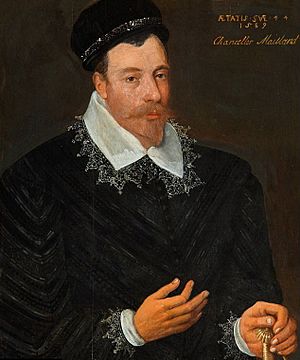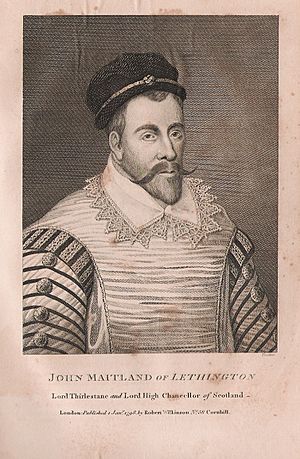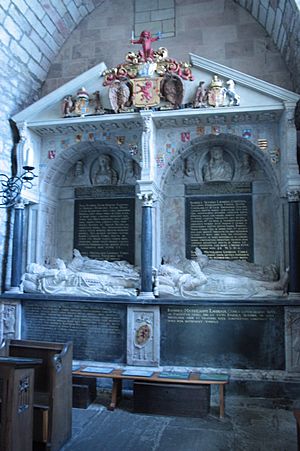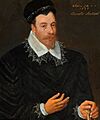John Maitland, 1st Lord Maitland of Thirlestane facts for kids

John Maitland, 1st Lord Maitland of Thirlestane (born 1537 – died 3 October 1595) was an important Scottish politician. He was the Lord Chancellor of Scotland, which was a very powerful job, like being the chief legal advisor and head of the government. He lived at Lethington and was made a Knight in 1581.
Life of John Maitland
John Maitland was the second son of Sir Richard Maitland. His father gave him land in Thirlestane and sent him to study abroad.
When he returned to Scotland, his older brother, William Maitland of Lethington, helped him get a job. John first became the head of Kelso Abbey. Later, he traded this job with Francis Stewart, 1st Earl of Bothwell for the Priory of Coldingham. Mary, Queen of Scots approved this trade in 1567.
After his father died, John became the Keeper of the Privy Seal of Scotland in 1567. This meant he was in charge of the King's special seal used on important documents. He also supported Regent Moray, who was ruling Scotland for the young King James VI. John was made a judge in the College of Justice in 1568.
Scotland faced a civil war after Regent Moray was killed. John Maitland joined the side that supported the Queen. Because of this, the King's supporters declared him a rebel in 1570. He lost all his jobs and lands.
John Maitland then hid in Edinburgh Castle. When the castle was taken in 1573, he was sent to Tantallon Castle as a prisoner. After nine months, he was moved to Cowthallie under house arrest. In 1575, he was officially forgiven and got his old title back.
In 1581, he was again made Keeper of the Privy Seal of Scotland. He also became a Privy Counsellor, advising the King. In 1584, he became the Secretary of Scotland. This was a very important role, like being a top government minister. He got back all his honors and jobs.
In 1585, the plague came to Edinburgh. King James VI and his advisors, including Maitland, went to Dirleton Castle. There, they enjoyed a big feast and a play about Robin Hood.
John Maitland became Vice-Chancellor in 1586. Later that year, he was appointed Lord Chancellor of Scotland. This made him one of the most powerful people in the country. In 1587, he was given the barony of Stobo as well.
Some powerful nobles tried to get rid of Maitland in 1589. They planned to capture the King and kill Maitland. But the King and Maitland were not at Holyrood Palace when they attacked, so the plan failed. Other plots against him also failed.
Maitland and Anne of Denmark
In 1589, John Maitland traveled with James VI to Norway and Denmark. The King was going there to marry Anne of Denmark. Maitland helped pay for this trip and managed the money. He even paid for one ship and half of another. The ships were filled with lots of food and drinks, showing the King's secret plan to meet Anne.
Maitland's records show he prepared a ship called the James Royall. It was fitted with cannons, painted, and given new flags. Carpenters built new storage areas for food. There were barrels of English beer and wine from the King's cellars.
In Oslo, Norway, some of Anne of Denmark's ladies-in-waiting asked Maitland to help them. They wanted him to ask King James VI to forgive David Cunningham of Robertland. David had fled Scotland after a murder in 1586 and was welcomed at the Danish court. Maitland and the ladies spoke to the King, and David was pardoned.
King James VI also asked Maitland to give gifts of silver to Danish advisors. This silver was a gift to James from Queen Elizabeth. James also ordered Maitland to give jewels to Christian IV of Denmark and his mother Sophie of Mecklenburg-Güstrow.
After returning to Scotland in 1590, Maitland was made a Lord of Parliament. He was given the title Lord Maitland of Thirlestane. Anne of Denmark's mother, Sophie, asked him to help set up Anne's royal household in Scotland. In July 1590, Maitland met with Anne at Dunfermline Palace to help her choose her ladies and gentlewomen.
King James VI visited Thirlestane Castle in 1591 to celebrate the marriage of Maitland's niece. This marriage helped Maitland become friends with Anne of Denmark. Anne's mother, Sophie, even sent Maitland a thank-you letter.
Maitland also helped the King with problems in the royal households. In 1591, some kitchen staff left their jobs because of pay issues. James asked Maitland to fix this.
Anne of Denmark and Maitland had some disagreements. Anne believed she should own lands called Musselburgh and Inveresk, which belonged to Maitland. These lands were given to her in 1592 after a Danish ambassador spoke to Maitland. Anne also became unhappy with Maitland's power. In 1593, she complained about him and his wife, Jean Fleming. In 1594, King James VI asked Anne's brother, Christian IV, to help Anne forgive Maitland.
By February 1595, it seems Maitland's relationship with the Queen had improved. He had made friends with her advisors.
In July 1595, Maitland wrote to the Earl of Essex in England about sharing information. Essex replied that he would be happy to receive letters from Maitland.
Death and Legacy
John Maitland died on 3 October 1595 at Thirlestane Castle after being sick for a month. He was buried in a special chapel at St. Mary's in Haddington. King James VI wrote a poem for his tomb.
Sir John Scot of Scotstarvet, who wrote in the 1600s, said that John Maitland was an excellent Latin poet. He also mentioned that King James thought highly of him.
A painting of John Maitland by Adrian Vanson was found to be painted over an earlier image of Mary, Queen of Scots.
Family
John Maitland had two famous siblings:
- William Maitland of Lethington, who was also a Scottish Secretary of State.
- Marie Maitland, who was known for writing down old Scottish poems and stories.
John Maitland married Jean Fleming in January 1583. They had two children:
- Anne (1589–1609), who married Robert Seton, 2nd Earl of Winton. They did not have any children.
- John Maitland, 1st Earl of Lauderdale
Images for kids
-
Sir John Maitland, attributed to Adrian Vanson






